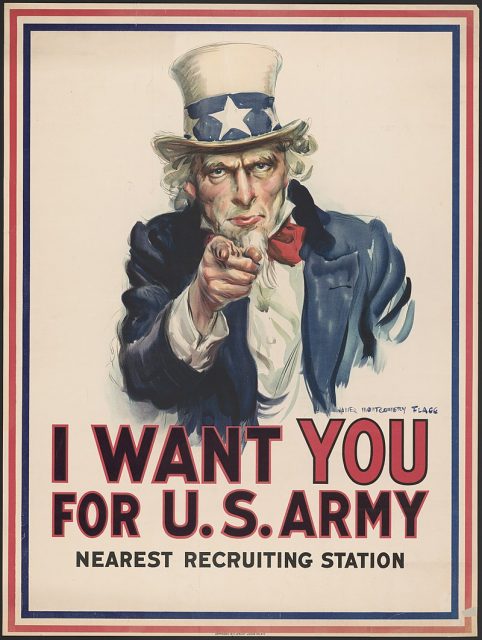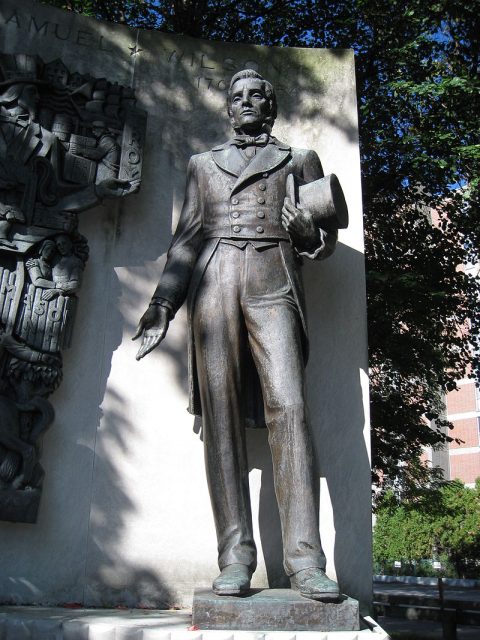What Is the Art Style of Original Uncle Sam
"I want You for the U.S. Regular army." Iv million copies of this archetype Uncle Sam recruiting affiche were plastered on billboards across America during World War I. The skinny, scowling, bearded Sam, with his commanding pointer finger, would become one of the nigh recognizable images of the century. He was basically a self-portrait by the illustrator. But in fact James Montgomery Flagg was much more interested in pretty women than politics.
Flagg, who was born in New York in 1877, began cartoon as a child and sold his first illustration to a magazine for $10 when he was simply 12 years old. He became a contributing illustrator to Judge and Life magazines while he was still a teenager. Flagg studied art at the Art Students League in New York and fine arts in both London and France, before returning to commercial work in the U.S.
Flagg's illustrations appeared in all the major magazines of the twenty-four hour period, including Colliers, Cosmopolitan, Redbook, and the Saturday Evening Post, among many others. He won a commission to illustrate P.Grand. Wodehouse's character Jeeves. Flagg'due south piece of work was in such demand that he in one case boasted he was creating an illustration a day. He was purportedly the highest-paid illustrator of his time.

Mr. James Montgomery Flagg
Flagg enjoyed the perks of his fame, hobnobbing with the likes of publisher William Randolph Hearst and actor John Barrymore. For the proto-glory magazine Photoplay, Flagg painted Hollywood starlets. Though he was married to a woman eleven years his senior, he had fairly public diplomacy with several of his subjects. Later in his autobiography, Roses and Buckshot, he would write that they weren't love diplomacy only "lust affairs." He claimed he couldn't resist the attraction of attractive women. Of the actress Hedy LaMarr, Flagg wrote, "Information technology would exist but a blind and deaf man who wouldn't fall in love with her."

J. M. Flagg'south 1917 poster was based on the original British Lord Kitchener poster of three years earlier. Information technology was used to recruit soldiers for both World War I and World War Ii. Flagg used a modified version of his own face for Uncle Sam, and veteran Walter Botts provided the pose.
During World War I, Flagg was appointed New York State military creative person. His famous Uncle Sam image first appeared on the encompass of the July 6, 1916, issue of Leslie's Weekly mag, with the headline "What are Yous doing for preparedness?" Flagg repurposed the painting for the U.S. Army the following year, and it was reprinted again during WWII. The famous recruitment poster saw a revival during the 1960s, though sometimes with a hint of that era's irony.
Flagg'due south Uncle Sam was almost certainly inspired past a similar 1914 British poster designed by Alfred Leete, which depicted a mustachioed Lord Kitchener, the British secretary of country for war, pointing and saying "Your country needs You lot." Flagg fabricated a total of 46 propaganda posters and agreed to paint a portrait of anyone who contributed $1,000 to the Liberty Bond state of war endeavour.
The only known prototype of Samuel Wilson, meat-packer from Troy, New York, whose name is purportedly the source of the personification of the The states known as Uncle Sam.
During WWII, Flagg painted a companion affiche, "Speed Up America," for which he received a commendation from President Franklin D. Roosevelt. The poster featured the aforementioned skinny, bearded Uncle Sam, who greatly resembled Flagg himself, running away from a burning swastika. "I congratulate you on your resourcefulness in saving on your model hire," President Roosevelt said at the anniversary about the artist using himself in his work, according to the Smithsonian National Museum of American History. "Your method suggests our Yankee forebearers."
Subsequently the war, Flagg connected illustrating, and also wrote short stories and appeared in plays, but his health and eyesight began to fail him. He published his autobiography in 1946, which, like his many letters to newspapers and magazines, was full of sexist comments common to that time.

Samuel Wilson Memorial in Arlington, Massachusetts
Photo: Daderot CC By-SA 3.0
Flagg said that "physically bonny women are the most plentiful thing produced in America," according to a May 28, 1960, obituary in the New York Times, adding that the type he preferred was "Not intellectual, but a lady."
Related story from the states: The buff WWII-era feminist icon Rosie the Riveter was actually a tiny telegraph operator who'd never been near a factory
Flagg was 82 when he died in 1960. "Mr. Flagg was noted both for his patriotic state of war posters and his magazine illustrations of lovely women," as the Times noted. "A frank iconoclast, he had little use either for 'modernistic' art or the 'stuffy' type of business executive."
Source: https://www.thevintagenews.com/2018/03/14/uncle-sam-wants-you-2/
0 Response to "What Is the Art Style of Original Uncle Sam"
Postar um comentário